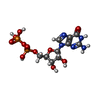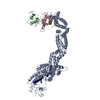[English] 日本語
 Yorodumi
Yorodumi- EMDB-18657: PROTAC-mediated complex of KRAS with VHL/Elongin-B/Elongin-C/Cull... -
+ Open data
Open data
- Basic information
Basic information
| Entry |  | |||||||||
|---|---|---|---|---|---|---|---|---|---|---|
| Title | PROTAC-mediated complex of KRAS with VHL/Elongin-B/Elongin-C/Cullin-2/Rbx1 | |||||||||
 Map data Map data | sharpened by deepemhancer | |||||||||
 Sample Sample |
| |||||||||
 Keywords Keywords | TARGETED PROTEIN DEGRADATION / PROTAC / GTPASE / TRANSFERASE | |||||||||
| Function / homology |  Function and homology information Function and homology informationregulation of cellular response to hypoxia / cullin-RING-type E3 NEDD8 transferase / NEDD8 transferase activity / cullin-RING ubiquitin ligase complex / RHOBTB3 ATPase cycle / negative regulation of receptor signaling pathway via JAK-STAT / Cul7-RING ubiquitin ligase complex / ubiquitin-dependent protein catabolic process via the C-end degron rule pathway / cellular response to chemical stress / Loss of Function of FBXW7 in Cancer and NOTCH1 Signaling ...regulation of cellular response to hypoxia / cullin-RING-type E3 NEDD8 transferase / NEDD8 transferase activity / cullin-RING ubiquitin ligase complex / RHOBTB3 ATPase cycle / negative regulation of receptor signaling pathway via JAK-STAT / Cul7-RING ubiquitin ligase complex / ubiquitin-dependent protein catabolic process via the C-end degron rule pathway / cellular response to chemical stress / Loss of Function of FBXW7 in Cancer and NOTCH1 Signaling / transcription elongation factor activity / target-directed miRNA degradation / elongin complex / positive regulation of protein autoubiquitination / RNA polymerase II transcription initiation surveillance / protein neddylation / Replication of the SARS-CoV-1 genome / NEDD8 ligase activity / VCB complex / negative regulation of response to oxidative stress / Cul5-RING ubiquitin ligase complex / response to mineralocorticoid / GMP binding / SCF ubiquitin ligase complex / negative regulation of type I interferon production / forebrain astrocyte development / ubiquitin-ubiquitin ligase activity / intracellular membraneless organelle / SCF-dependent proteasomal ubiquitin-dependent protein catabolic process / LRR domain binding / Cul2-RING ubiquitin ligase complex / Cul3-RING ubiquitin ligase complex / regulation of synaptic transmission, GABAergic / negative regulation of epithelial cell differentiation / Cul4A-RING E3 ubiquitin ligase complex / response to isolation stress / Cul4-RING E3 ubiquitin ligase complex / SUMOylation of ubiquitinylation proteins / negative regulation of mitophagy / Prolactin receptor signaling / Cul4B-RING E3 ubiquitin ligase complex / response to gravity / epithelial tube branching involved in lung morphogenesis / ubiquitin ligase complex scaffold activity / type I pneumocyte differentiation / Rac protein signal transduction / positive regulation of Rac protein signal transduction / Signaling by RAS GAP mutants / Signaling by RAS GTPase mutants / Activation of RAS in B cells / myoblast proliferation / cullin family protein binding / negative regulation of transcription elongation by RNA polymerase II / RAS signaling downstream of NF1 loss-of-function variants / Pausing and recovery of Tat-mediated HIV elongation / Tat-mediated HIV elongation arrest and recovery / skeletal muscle cell differentiation / RUNX3 regulates p14-ARF / positive regulation of glial cell proliferation / HIV elongation arrest and recovery / Pausing and recovery of HIV elongation / SOS-mediated signalling / Activated NTRK3 signals through RAS / Activated NTRK2 signals through RAS / SHC1 events in ERBB4 signaling / protein monoubiquitination / cardiac muscle cell proliferation / Signalling to RAS / Activated NTRK2 signals through FRS2 and FRS3 / negative regulation of signal transduction / SHC-related events triggered by IGF1R / Tat-mediated elongation of the HIV-1 transcript / Estrogen-stimulated signaling through PRKCZ / glial cell proliferation / SHC-mediated cascade:FGFR3 / Formation of HIV-1 elongation complex containing HIV-1 Tat / MET activates RAS signaling / ubiquitin-like ligase-substrate adaptor activity / protein K48-linked ubiquitination / SHC-mediated cascade:FGFR2 / Formation of HIV elongation complex in the absence of HIV Tat / Signaling by PDGFRA transmembrane, juxtamembrane and kinase domain mutants / Signaling by PDGFRA extracellular domain mutants / SHC-mediated cascade:FGFR4 / PTK6 Regulates RHO GTPases, RAS GTPase and MAP kinases / Erythropoietin activates RAS / SHC-mediated cascade:FGFR1 / Signaling by FGFR4 in disease / Signaling by CSF3 (G-CSF) / FRS-mediated FGFR3 signaling / Nuclear events stimulated by ALK signaling in cancer / RNA Polymerase II Transcription Elongation / Signaling by FLT3 ITD and TKD mutants / Formation of RNA Pol II elongation complex / FRS-mediated FGFR2 signaling / FRS-mediated FGFR4 signaling / FRS-mediated FGFR1 signaling / p38MAPK events / Signaling by FGFR3 in disease / protein-membrane adaptor activity Similarity search - Function | |||||||||
| Biological species |  Homo sapiens (human) Homo sapiens (human) | |||||||||
| Method | single particle reconstruction / cryo EM / Resolution: 3.5 Å | |||||||||
 Authors Authors | Fischer G / Peter D / Arce-Solano S | |||||||||
| Funding support |  Austria, 1 items Austria, 1 items
| |||||||||
 Citation Citation |  Journal: Science / Year: 2024 Journal: Science / Year: 2024Title: Targeting cancer with small-molecule pan-KRAS degraders. Authors: Johannes Popow / William Farnaby / Andreas Gollner / Christiane Kofink / Gerhard Fischer / Melanie Wurm / David Zollman / Andre Wijaya / Nikolai Mischerikow / Carina Hasenoehrl / Polina ...Authors: Johannes Popow / William Farnaby / Andreas Gollner / Christiane Kofink / Gerhard Fischer / Melanie Wurm / David Zollman / Andre Wijaya / Nikolai Mischerikow / Carina Hasenoehrl / Polina Prokofeva / Heribert Arnhof / Silvia Arce-Solano / Sammy Bell / Georg Boeck / Emelyne Diers / Aileen B Frost / Jake Goodwin-Tindall / Jale Karolyi-Oezguer / Shakil Khan / Theresa Klawatsch / Manfred Koegl / Roland Kousek / Barbara Kratochvil / Katrin Kropatsch / Arnel A Lauber / Ross McLennan / Sabine Olt / Daniel Peter / Oliver Petermann / Vanessa Roessler / Peggy Stolt-Bergner / Patrick Strack / Eva Strauss / Nicole Trainor / Vesna Vetma / Claire Whitworth / Siying Zhong / Jens Quant / Harald Weinstabl / Bernhard Kuster / Peter Ettmayer / Alessio Ciulli /     Abstract: Mutations in the Kirsten rat sarcoma viral oncogene homolog (KRAS) protein are highly prevalent in cancer. However, small-molecule concepts that address oncogenic KRAS alleles remain elusive beyond ...Mutations in the Kirsten rat sarcoma viral oncogene homolog (KRAS) protein are highly prevalent in cancer. However, small-molecule concepts that address oncogenic KRAS alleles remain elusive beyond replacing glycine at position 12 with cysteine (G12C), which is clinically drugged through covalent inhibitors. Guided by biophysical and structural studies of ternary complexes, we designed a heterobifunctional small molecule that potently degrades 13 out of 17 of the most prevalent oncogenic KRAS alleles. Compared with inhibition, KRAS degradation results in more profound and sustained pathway modulation across a broad range of KRAS mutant cell lines, killing cancer cells while sparing models without genetic KRAS aberrations. Pharmacological degradation of oncogenic KRAS was tolerated and led to tumor regression in vivo. Together, these findings unveil a new path toward addressing KRAS-driven cancers with small-molecule degraders. #1:  Journal: Biorxiv / Year: 2023 Journal: Biorxiv / Year: 2023Title: Targeting cancer with small molecule pan-KRAS degraders Authors: Popow J / Farnaby W / Gollner A / Kofink C / Fischer G / Wurm M / Zollman D / Wijaya A / Mischerikow N / Hasenoehrl C / Prokofeva P / Arnhof H / Arce-Solano S / Bell S / Boeck G / Diers E / ...Authors: Popow J / Farnaby W / Gollner A / Kofink C / Fischer G / Wurm M / Zollman D / Wijaya A / Mischerikow N / Hasenoehrl C / Prokofeva P / Arnhof H / Arce-Solano S / Bell S / Boeck G / Diers E / Frost A / Goodwin-Tindall J / Karolyi-Oezguer J / Khan S / Klawatsch T / Koegl M / Kousek R / Kratochvil B / Kropatsch K / Lauber A / McLennan R / Olt S / Peter D / Petermann O / Roessler V / Stolt-Bergner P / Strack P / Strauss E / Trainor N / Vetma V / Whitworth C / Zhong S / Quant J / Weinstabl H / Kuster B / Ettmayer P / Ciulli A | |||||||||
| History |
|
- Structure visualization
Structure visualization
| Supplemental images |
|---|
- Downloads & links
Downloads & links
-EMDB archive
| Map data |  emd_18657.map.gz emd_18657.map.gz | 189 MB |  EMDB map data format EMDB map data format | |
|---|---|---|---|---|
| Header (meta data) |  emd-18657-v30.xml emd-18657-v30.xml emd-18657.xml emd-18657.xml | 32.9 KB 32.9 KB | Display Display |  EMDB header EMDB header |
| FSC (resolution estimation) |  emd_18657_fsc.xml emd_18657_fsc.xml | 14.4 KB | Display |  FSC data file FSC data file |
| Images |  emd_18657.png emd_18657.png | 98.1 KB | ||
| Filedesc metadata |  emd-18657.cif.gz emd-18657.cif.gz | 8.2 KB | ||
| Others |  emd_18657_additional_1.map.gz emd_18657_additional_1.map.gz emd_18657_half_map_1.map.gz emd_18657_half_map_1.map.gz emd_18657_half_map_2.map.gz emd_18657_half_map_2.map.gz | 201.4 MB 3.3 MB 3.3 MB | ||
| Archive directory |  http://ftp.pdbj.org/pub/emdb/structures/EMD-18657 http://ftp.pdbj.org/pub/emdb/structures/EMD-18657 ftp://ftp.pdbj.org/pub/emdb/structures/EMD-18657 ftp://ftp.pdbj.org/pub/emdb/structures/EMD-18657 | HTTPS FTP |
-Validation report
| Summary document |  emd_18657_validation.pdf.gz emd_18657_validation.pdf.gz | 444.3 KB | Display |  EMDB validaton report EMDB validaton report |
|---|---|---|---|---|
| Full document |  emd_18657_full_validation.pdf.gz emd_18657_full_validation.pdf.gz | 443.8 KB | Display | |
| Data in XML |  emd_18657_validation.xml.gz emd_18657_validation.xml.gz | 21.6 KB | Display | |
| Data in CIF |  emd_18657_validation.cif.gz emd_18657_validation.cif.gz | 28.3 KB | Display | |
| Arichive directory |  https://ftp.pdbj.org/pub/emdb/validation_reports/EMD-18657 https://ftp.pdbj.org/pub/emdb/validation_reports/EMD-18657 ftp://ftp.pdbj.org/pub/emdb/validation_reports/EMD-18657 ftp://ftp.pdbj.org/pub/emdb/validation_reports/EMD-18657 | HTTPS FTP |
-Related structure data
| Related structure data |  8qu8M M: atomic model generated by this map |
|---|---|
| Similar structure data | Similarity search - Function & homology  F&H Search F&H Search |
- Links
Links
| EMDB pages |  EMDB (EBI/PDBe) / EMDB (EBI/PDBe) /  EMDataResource EMDataResource |
|---|---|
| Related items in Molecule of the Month |
- Map
Map
| File |  Download / File: emd_18657.map.gz / Format: CCP4 / Size: 216 MB / Type: IMAGE STORED AS FLOATING POINT NUMBER (4 BYTES) Download / File: emd_18657.map.gz / Format: CCP4 / Size: 216 MB / Type: IMAGE STORED AS FLOATING POINT NUMBER (4 BYTES) | ||||||||||||||||||||||||||||||||||||
|---|---|---|---|---|---|---|---|---|---|---|---|---|---|---|---|---|---|---|---|---|---|---|---|---|---|---|---|---|---|---|---|---|---|---|---|---|---|
| Annotation | sharpened by deepemhancer | ||||||||||||||||||||||||||||||||||||
| Projections & slices | Image control
Images are generated by Spider. | ||||||||||||||||||||||||||||||||||||
| Voxel size | X=Y=Z: 0.99333 Å | ||||||||||||||||||||||||||||||||||||
| Density |
| ||||||||||||||||||||||||||||||||||||
| Symmetry | Space group: 1 | ||||||||||||||||||||||||||||||||||||
| Details | EMDB XML:
|
-Supplemental data
-Additional map: unsharpened map from 3D flex
| File | emd_18657_additional_1.map | ||||||||||||
|---|---|---|---|---|---|---|---|---|---|---|---|---|---|
| Annotation | unsharpened map from 3D flex | ||||||||||||
| Projections & Slices |
| ||||||||||||
| Density Histograms |
-Half map: half map B
| File | emd_18657_half_map_1.map | ||||||||||||
|---|---|---|---|---|---|---|---|---|---|---|---|---|---|
| Annotation | half map B | ||||||||||||
| Projections & Slices |
| ||||||||||||
| Density Histograms |
-Half map: half map A
| File | emd_18657_half_map_2.map | ||||||||||||
|---|---|---|---|---|---|---|---|---|---|---|---|---|---|
| Annotation | half map A | ||||||||||||
| Projections & Slices |
| ||||||||||||
| Density Histograms |
- Sample components
Sample components
+Entire : KRAS/ACBI3/VHL/EloB/EloC/Cul2/Rbx1
+Supramolecule #1: KRAS/ACBI3/VHL/EloB/EloC/Cul2/Rbx1
+Macromolecule #1: von Hippel-Lindau disease tumor suppressor
+Macromolecule #2: Elongin-B
+Macromolecule #3: Elongin-C
+Macromolecule #4: Cullin-2
+Macromolecule #5: E3 ubiquitin-protein ligase RBX1, N-terminally processed
+Macromolecule #6: GTPase KRas
+Macromolecule #7: ZINC ION
+Macromolecule #8: GUANOSINE-5'-DIPHOSPHATE
+Macromolecule #9: (2S,4R)-1-[(2S)-2-[4-[4-[(3S)-4-[4-[5-[(4S)-2-azanyl-3-cyano-4-me...
-Experimental details
-Structure determination
| Method | cryo EM |
|---|---|
 Processing Processing | single particle reconstruction |
| Aggregation state | particle |
- Sample preparation
Sample preparation
| Concentration | 0.916 mg/mL | ||||||||||
|---|---|---|---|---|---|---|---|---|---|---|---|
| Buffer | pH: 7.5 Component:
| ||||||||||
| Grid | Model: Quantifoil R1.2/1.3 / Material: COPPER / Mesh: 200 / Support film - Material: CARBON / Support film - topology: HOLEY / Pretreatment - Type: GLOW DISCHARGE / Pretreatment - Time: 15 sec. / Pretreatment - Atmosphere: AIR | ||||||||||
| Vitrification | Cryogen name: ETHANE / Chamber humidity: 95 % / Chamber temperature: 4 K / Instrument: FEI VITROBOT MARK IV |
- Electron microscopy
Electron microscopy
| Microscope | FEI TITAN KRIOS |
|---|---|
| Specialist optics | Energy filter - Name: TFS Selectris / Energy filter - Slit width: 10 eV |
| Image recording | Film or detector model: FEI FALCON IV (4k x 4k) / Number grids imaged: 1 / Number real images: 7634 / Average electron dose: 40.0 e/Å2 |
| Electron beam | Acceleration voltage: 300 kV / Electron source:  FIELD EMISSION GUN FIELD EMISSION GUN |
| Electron optics | Illumination mode: FLOOD BEAM / Imaging mode: BRIGHT FIELD / Cs: 2.7 mm / Nominal defocus max: 2.0 µm / Nominal defocus min: 0.8 µm / Nominal magnification: 165000 |
| Sample stage | Specimen holder model: FEI TITAN KRIOS AUTOGRID HOLDER |
| Experimental equipment |  Model: Titan Krios / Image courtesy: FEI Company |
 Movie
Movie Controller
Controller






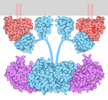






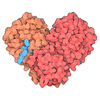



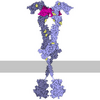






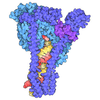








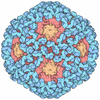

 Z (Sec.)
Z (Sec.) Y (Row.)
Y (Row.) X (Col.)
X (Col.)













































